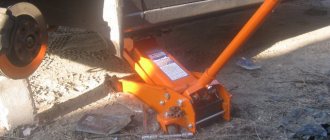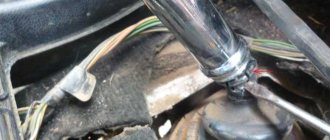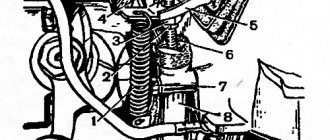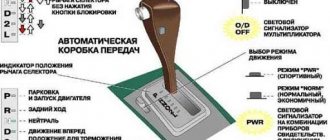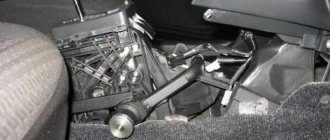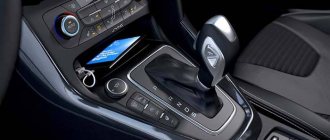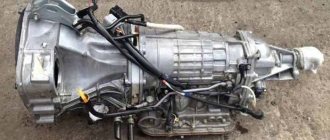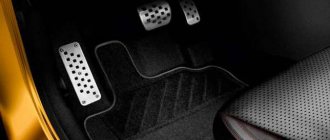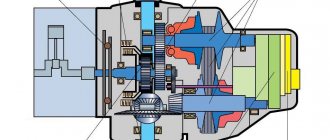Chaika GAZ-13 - automatic transmission unit
Of the Soviet cars, the Chaika GAZ-13 sported a push-button automatic transmission unit.
Of the Soviet cars, the Chaika GAZ-13 sported a push-button automatic transmission unit.
The rarest type of control is push-button. Connoisseurs of retro technology will remember, for example, the Soviet limousine GAZ-13 Chaika, where the four-button unit was located to the left of the steering wheel on the front panel. The scheme did not take root on passenger cars, and today only a few lucky people can see it, for example, owners of Ferrari and Aston Martin supercars. But for buses, mode selection keys are in order. On the contrary, it is almost impossible to find a different type of automatic transmission control.
Push-button automatic control
Push-button automatic control is a rarity in passenger cars.
The photo shows an Aston Martin Rapide with mode selection buttons under the central ventilation vents. Push-button automatic control is a rarity in passenger cars. The photo shows an Aston Martin Rapide with mode selection buttons under the central ventilation vents.
Another type of automatic control has become widespread in recent history. This is a rotating washer, which is simultaneously made recessed when not in use - a stylish and non-standard solution. The British brands Jaguar and Land Rover have been noticed to be partial to it. The entire model range of the two brands has switched to washers. Surprisingly, the brutal Ram pickup truck takes a similar approach. The automobile god himself told him to be faithful to American traditions!
Pickup RAM
It's hard to accuse the RAM pickup truck of being unfaithful to American values.
But look at his automatic control puck! It's hard to accuse the RAM pickup truck of being unfaithful to American values. But look at his automatic control puck!
The history of automatic machines began with the steering column “poker.” They came to the automotive world from the USA at the beginning of the last century, where the fashion for this selector arrangement lasted for many decades. Now it is close to extinction. Thus, of the “big three” best-selling pickup trucks, only the Chevrolet Silverado is loyal to it, while the Ford F-150 and Ram have signed up as renegades.
Operating principle of automatic transmission
It is forbidden to switch automatic transmissions because the automatic transmission is not capable of switching quickly, as, for example, owners of manual transmissions do. It's all about the operating principle of the automatic transmission.
- When the engine starts, the pump wheel and turbine begin to rotate. They push the lubricant, which here not only plays a passive role as a lubricant, but also participates as a pressure regulator. This work occurs under the influence of centrifugal force.
- The oil flies back, landing on the reactor blades. And from there it hits the pump wheel with higher force, increasing the rotation speed of the internal combustion engine.
- The fluid coupling makes the planetary gearbox work.
- And it is already controlled by the hydraulic unit, which, together with the electronic control unit, is the main “brain” of the entire automatic transmission system.
- It launches an algorithm for fixing the components of the planetary gearbox and forces it to automatically change gears in the box.
Read
Features of operation and maintenance of automatic transmission
The automatic transmission does not allow the engine to operate at full power, thereby maintaining its health and increasing its service life.
Attention! On vehicles with automatic transmission, you cannot start abruptly from a standstill or start driving with an unheated transmission in the cold season. This will lead to rapid wear of the machine’s components and will speed up the time for major repairs or even restoration of the box.
The correct method for controlling the machine is as follows:
- Turn on the ignition. Allow the vehicle to warm up to operating temperature for three minutes.
- Press the brake pedal. Switch the automatic transmission selector knob to the “Forward” or “Reverse” position.
- Release the brake and press the gas without sudden movements. Don't accelerate from the start.
In winter, be sure to warm up the machine for five minutes. You can switch the selector handle while pressing the brake pedal before the car owner moves away. This will allow the oil to get into all automatic transmission components and lubricate them before driving.
Read
Typical problems and repairs of automatic transmission f4a42
Cadillac Escalade
The Cadillac Escalade (pictured) and its companion Chevrolet Tahoe are true to American traditions: a massive automatic poker sticks out from under the steering wheel.
The Cadillac Escalade (pictured) and its companion Chevrolet Tahoe are true to American traditions: a massive automatic poker sticks out from under the steering wheel.
Of the other brands, only Mercedes-Benz has been noticed in mass use of a scheme with a selector on the steering column, which began switching to it in the mid-2000s. BMW had only one attempt - on the seventh series in the E65 body of 2001. Even the two-door “six”, related to it in style, remained faithful to the classics, like the next generation of the flagship, presented in 2008.
One could say that we too have joined this trend. But, alas, automatic transmission debuted on domestic cars for the mass consumer only on the Lada Grant in 2012. Although the lever under the steering wheel was very familiar to Soviet drivers, because it appeared immediately after the war on the Pobeda.
Interior of Lada and Bentley
The classic arrangement of the automatic transmission lever - from Lada to Bentley.
The classic arrangement of the automatic transmission lever - from Lada to Bentley.
The most popular type of automatic selector is located on the central tunnel between the front seats. The vast majority of automobile brands with an annual total production volume of tens of millions of cars remain faithful to the classics. Although in the premium segment the lever mechanically connected to the gearbox is a thing of the past, leaving in its place a rudimentary electronic joystick.
Here we come to another nuance of controlling automatic transmissions. Until the 1990s, the mass consumer did not even think that, having paid extra for an automatic transmission when buying a car, he would suddenly need to click the gears manually. However, engineers came up with a new “trick”, and marketers quickly explained its benefits. This is how all kinds of step, type and other “tronics” appeared. In other words, a manual gear selection function for an automatic transmission.
Off-road
In general, in severe off-road conditions it is best to drive with a manual transmission. Even modern automatic transmissions have difficulty distinguishing all the nuances of the road situation in difficult conditions. They often overheat and fail completely. But if you find yourself off-road, then don't panic.
First, assess the road situation. If you just hit a bad road and the car can continue moving, you need to reduce the speed to 20 -30 km/h and switch to second gear.
When the car is sitting in the mud or driving very slowly, it is best to use the lever. That is, turn on the “L” and “2” gears alternately. This way, you will protect yourself from excessive acceleration and get the necessary torque to drive through a difficult section of the road.
Audi A4 steering wheel
One of the first implementations of manual control of a gearbox without the help of a selector was using buttons on the steering wheel spokes on the Audi A4 of the late 1990s.
One of the first implementations of manual control of a gearbox without the help of a selector was using buttons on the steering wheel spokes on the Audi A4 of the late 1990s.
Even with the same classic location of the selector on the central tunnel, manufacturers did not have unity in implementing the manual mode. For example, let’s take the models of the “German Big Three” from the second half of the 1990s. Audi required you to move the lever to the right from position D and change gears using back and forth movements. The BMW concern used the same scheme, but the lever had to be moved to the left. And Mercedes knew how to switch gears directly from mode D by swinging the selector left and right.
With the further spread of manual automatic transmission control, almost all cars were divided into two camps. Budget and mass-market ones still have switching using the selector by moving it to a separate slot to the left or right of the main one. The exception is a number of Chevrolet, Opel and Ford models, which use an extremely inconvenient key located on the lever under the thumb. Even the Koreans once used a similar scheme on their SsangYong Actyon and, apparently, remained faithful to it on the new Tivoli model, with which they plan to return to the Russian market.
Some tips for switching modes correctly
The number of automatic transmission operating modes depends on the box model. The main ones are located on the selector panel. You need to control the machine’s programs by moving the lever to the desired position:
- “P” - “Parking” blocks the drive wheels, so it is used for long-term parking. Equivalent to a pulled handbrake. You can switch to the mode only after stopping;
- “N” - “Neutral” does not block the wheels, so the car can roll if the handbrake is not tightened;
- "D" - "Drive" allows the car to move forward. The system automatically selects the gear that is suitable for the driving conditions. The acceleration speed depends on the force of pressing the accelerator. When you smoothly release the pedal, the car will be braked by the engine;
- "R" - "Reverse" or "Reverse". It is permissible to control “Reverse” only after stopping.
Read
Which is better and more reliable, CVT or automatic
You can control automatic transmission programs only with the engine running:
- Step on the brake.
- Press the button on the selector handle (if equipped).
- Move the lever to the appropriate position.
A special feature of driving an automatic is the use of only the right foot, unlike a manual one. To switch the brake and accelerator, the foot is moved from one pedal to another. If you control both feet, in an emergency the wrong foot may work, which will lead to an accident.
Automatic selectors
On the left is the machine selector with a large key on top.
This can be seen in the interior of the Opel Mokka crossover. And on the right is the Aktion lever. The Koreans placed an inconspicuous joystick on the side. On the left is the machine selector with a large key on top. This can be seen in the interior of the Opel Mokka crossover. And on the right is the Aktion lever. The Koreans placed an inconspicuous joystick on the side.
And premium and sports cars have opted for a solution with steering wheel paddle shifters. One is responsible for upshifting, the other for downshifting. One of the pioneers in their implementation was Audi. True, in the late 1990s on the “four” from Ingolstadt these were not levers behind the steering wheel, but the “+” and “-” keys on its spokes.
How to change gears on an automatic transmission
The mode change occurs after appropriate actions by the driver - changing the position of the selector, pressing the pedals, etc. Gear shifting occurs automatically according to the selected driving function and depending on the engine speed.
Correct hand position when changing speed.
However, many car models with an automatic transmission are also equipped with a manual shift method. It can be designated as Tiptronic, Easytronic, Steptronic, etc.
When this function is enabled, the driver can independently select the optimal gear using the “+” and “-” buttons on the lever or the gradation on the dashboard.
This function is useful in cases where the driver’s reaction and experience are more effective than the automatic transmission algorithms: for example, when trying to start a slipping car, driving down a slope, driving on an uneven road, etc.
The mode is semi-automatic, so when high speeds are reached, the automatic transmission can change gear despite the driver's actions.
Lada Vesta and Lada Xray with AMT
Lada Vesta and Lada Xray: one gearbox, different control algorithms.
Lada Vesta and Lada Xray: one gearbox, different control algorithms.
Two new products from AVTOVAZ, Vesta and Xray, are equipped with the same automatic transmission (AMT). But for some reason the control algorithms are different. On a sedan, the overdrive is engaged by moving the lever away from you, on a crossover - towards you. In the automotive world, both options occur, but within the same brand the concept is usually the same. Considering that a robot with one clutch often requires switching to manual mode, the problem can be called significant. But only for those who drive Vesta and Xray alternately.
Automatic transmission: switch to manual control
